Dell Precision 7720 Can You Upgrade the Gpu to Nvidia Gtx 1080
Dell Precision 7720 (Xeon, P5000, 4K) Workstation Review
Fully specced. The Dell Precision wants to be the best mobile workstation with a mobile Xeon processor, plenty of RAM, Nvidia's new P5000 GPU, and a high-resolution PremierColor display.

The market for big mobile workstations (17-inch) is not that interesting this year, because none of the major manufacturers accept introduced new models. Instead, nosotros get evolutionary approaches that are mainly limited to the components. However, terminal year's models were hardly disappointing, so there is no criticism from our side. This is also the case for our exam model today, the Dell Precision 7720. Its predecessor Precision 7710 also managed a good score in our review.
As per usual in this segment, Dell offers many different components and individual configurations. It is no trouble to create a model perfectly suited for your requirements. Fast CPU with pocket-sized dGPU, or vice versa – no problem. All the same, this too creates a huge cost margin. Currently it starts at effectually 2200 Euros (~$2735), but tin can you speedily go into the five-figure range when you lot bank check all the boxes (plus VAT). Our examination model, which was provided past Dell, is well equipped including Xeon E3-1535M v6, 64 GB of RAM, the modern Nvidia Quadro P5000 with 16 GB of VRAM, and a loftier-resolution 4K PremierColor display, which promises total AdobeRGB gamut. This results in a toll of nearly 5500 Euros (~$6836; plus VAT), and the GPU is the biggest price factor.
The competition for the Precision 7720 traditionally includes the Lenovo ThinkPad P71 as well as HP's ZBook 17 G4, but we also include the corresponding systems from Fujitsu (Celsius H970) likewise as MSI (WE72).
The basic construction has non changed, which is why we will not cover all the sections in this review and focus on the new components instead. Nosotros recommend checking our review of the erstwhile Precision 7710 for more information on the case, the connectivity, the input devices, and the speakers.
Graphics adapter
NVIDIA Quadro P5000 - 16384 MB, Core: 1506 MHz, Memory: 1502 MHz, GDDR5, 385.69, Optimus
Memory
65536 MB
, DDR4-2400, Dual-Channel, four/4 slots in utilise
Brandish
17.xxx inch sixteen:9, 3840 10 2160 pixel 255 PPI, SHP1446 (LQ173D1), IGZO, sleeky: no
Weight
three.592 kg ( = 126.7 oz / 7.92 pounds), Power Supply: 972 g ( = 34.29 oz / ii.14 pounds)
Note: The manufacturer may use components from different suppliers including display panels, drives or memory sticks with similar specifications.
The basic construction of the 7720 is identical to the predecessor, but yous now become an additional Thunderbolt 3 port by default, which was still optional on the 7710. Information technology is located on the left side, only you all the same get four regular USB ports (3.0 with PowerShare). Thanks to the Mini-DisplayPort 1.four, the 7720 supports up to 8K video output with HDR. VR is another important topic, which is supported in combination with Nvidia's Pascal GPUs.
The quality of the examination sample meets the expectations for such a high price. The build quality is very good and all materials are nice to touch. All in all, the quality is on par with the ZBook 17 G4 from HP and one step above Lenovo's ThinkPad P71, followed by the mobile workstations from Fujitsu likewise as MSI. The following pictures show the predecessor Precision 7710 .
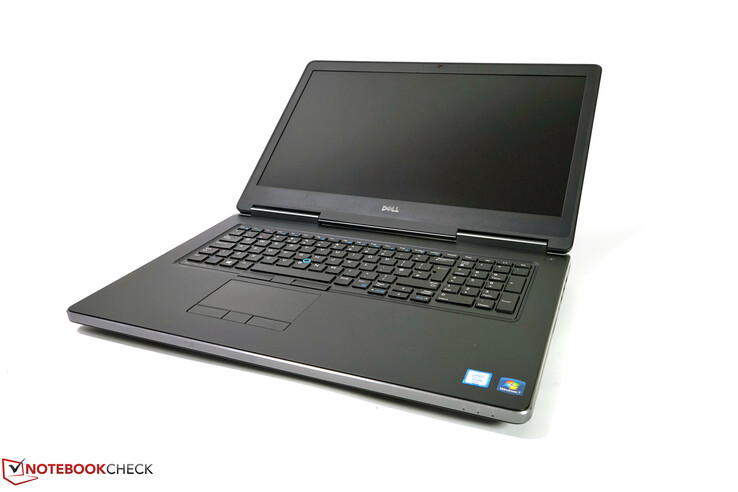
❌
The Precision 7720 features a full-size SD carte du jour reader. However, it did not work on our test model (even though it was activated in the BIOS). This should exist an isolated incident though. Dell ordinarily equips its Precision laptops with very fast carte readers. The slimPrecision 5520 is a good instance, where we determined transfer rates of more than 250 MB/s in combination with our reference card from Toshiba (Exceria Pro UHS-2 64 GB).
Also the Gigabit Ethernet jack (I219-LM), the Precision 7720 obviously also supports all mutual WLAN standards including fast 802.11ac likewise as Bluetooth 4.two. We have already reviewed the Intel 8265 many times and it is also used on many comparison devices. The transfer rates in combination with our reference router Linksys EA8500 are on the expected level when the device sends information, only the Dell is slower compared to the mobile workstations from Fujitsu and Lenovo when information technology receives information. We still enjoyed a stable network connection during our review period.
The Precision 7720 tin also be equipped with an LTE module (Snapdragon X7). The corresponding Micro-SIM slot is located within the case correct next to the WWAN module, and then you have to remove two covers at the bottom before you can access it. This is not a good solution and prevents a quick exchange of the carte du jour (in other countries, for example).
Dell ships the Precision 7720 with a three-year on-site service on the next business concern day past default. This service tin can be expanded upwardly to 5 years and you can add more than services during the checkout (keep your hard drive, boosted battery warranty, etc.).
Please run across our Guarantees, Return Policies and Warranties FAQ for country-specific information.
Dell offers three different 17.iii-inch panels for the Precision 7720. Except for the size and the matte surface, however, the three models have nothing in common. The default option is a TN panel with 1600x900 pixels and a color gamut of 42%, but Dell does not specify the reference (probably AdobeRGB). The 1080p IPS panel with 72% color gamut is bachelor for 60 Euros (~$75) extra.
The 4K console (3840x2160 pixels, IGZO, Sharp), which is too installed on our test model, charges a hefty additional charge of 425 Euros (~$528). Not but does Dell advertise it with 100% AdobeRGB gamut, but you also get the PremierColor software with enhanced color settings. You lot can, for case, set the color space that yous want to work in. We performed the following measurements with the defaultBrilliant preset compared to the AdobeRGB reference.
Subjectively, the pic looks very good. Nosotros tin measure an average luminance of more 440 nits, and the effulgence distribution at 89% is still okay considering the large panel size. The backlight bleeding at the lower edge is a bigger problem. Information technology is slightly intensified on our picture show, but you volition notice information technology on darker contents. Overall, the blackness value at 0.45 cd/m² is slightly high, just this is too a effect of the high luminance. It still results in a very good contrast ratio of more than than thousand:ane.
The brandish uses PWM for the brightness regulation every bit shortly equally the setting is at 20% or lower. The brightness levels of the Precision 7720 are very linear (the setting is 32% for the typical 150 nits), then you will be in this range quite often, especially in darker environments. The frequency is quite high at 1 kHz, but sensitive users should yet consider it.
Screen Flickering / PWM (Pulse-Width Modulation)
ℹ
To dim the screen, some notebooks will simply cycle the backlight on and off in rapid succession - a method called Pulse Width Modulation (PWM) . This cycling frequency should ideally exist undetectable to the human eye. If said frequency is too low, users with sensitive eyes may experience strain or headaches or even notice the flickering altogether.
| Screen flickering / PWM detected | 1020 Hz | ≤ xx % effulgence setting | 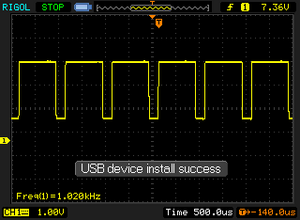 |
| The display backlight flickers at 1020 Hz (Probable utilizing PWM) Flickering detected at a brightness setting of 20 % and below. There should be no flickering or PWM above this effulgence setting. The frequency of 1020 Hz is quite loftier, so most users sensitive to PWM should not discover whatsoever flickering. In comparison: 52 % of all tested devices do not apply PWM to dim the display. If PWM was detected, an average of 20854 (minimum: v - maximum: 3846000) Hz was measured. | |||
| 415 cd/1000² | 440 cd/yard² | 434 cd/m² | ||
| 426 cd/chiliad² | 464 cd/thou² | 457 cd/m² | ||
| 426 cd/yard² | 447 cd/m² | 456 cd/one thousand² | ||
Distribution of brightness
SHP1446 (LQ173D1)
X-Rite i1Pro 2
Maximum: 464 cd/thousand² (Nits) Average: 440.6 cd/m² Minimum: 22.iii cd/thousand²
Brightness Distribution: 89 %
Center on Battery: 462 cd/1000²
Contrast: 1031:1 (Blackness: 0.45 cd/k²)
ΔE Color 3.2 | 0.59-29.43 Ø5.4
ΔE Greyscale four.two | 0.64-98 Ø5.7
100% sRGB (Argyll 1.half-dozen.3 3D)
88.1% AdobeRGB 1998 (Argyll one.half-dozen.3 3D)
99.xvi% AdobeRGB 1998 (Argyll 2.two.0 3D)
100% sRGB (Argyll 2.ii.0 3D)
87.55% Display P3 (Argyll 2.two.0 3D)
Gamma: 2.01
| Dell Precision 7720 SHP1446 (LQ173D1), , 3840x2160, 17.30 | Lenovo ThinkPad P71-20HK0004GE LEN4123, VVX17P051J00, , 3840x2160, 17.30 | HP ZBook 17 G4-Y3J82AV Sharp SHP144C, , 3840x2160, 17.thirty | MSI WE72 7RJ LP173WF4-SPF1, , 1920x1080, 17.thirty | Fujitsu Celsius H970 LP173WF4-SPF3, , 1920x1080, 17.30 | Dell Precision 7710 SDC8151, VHN17_173HL, , 1920x1080, 17.30 | |
|---|---|---|---|---|---|---|
| Display | 0% | -25% | -26% | -19% | ||
| Display P3 Coverage | 87.55 | 88.01 1% | 67.4 -23% | 66.81 -24% | 66.64 -24% | |
| sRGB Coverage | 100 | 100 0% | 85.28 -xv% | 84.56 -15% | 96.9 -three% | |
| AdobeRGB 1998 Coverage | 99.16 | 99.63 0% | 62.36 -37% | 61.83 -38% | 68.59 -31% | |
| Response Times | 41% | 7% | 34% | 45% | -14% | |
| Response Time Grey fifty% / Grey eighty% * | 60 ? | 39.2 ? 35% | 56.8 ? 5% | 45.2 ? 25% | 32 ? 47% | 50 ? 17% |
| Response Fourth dimension Black / White * | 46.4 ? | 23.2 ? 50% | 38.iv ? 17% | 26.iv ? 43% | 26.4 ? 43% | 36 ? 22% |
| PWM Frequency | 1020 ? | 1412 ? 38% | 1020 ? 0% | 198 ? -81% | ||
| Screen | 10% | 17% | -33% | -28% | -vii% | |
| Brightness middle | 464 | 358 -23% | 391 -xvi% | 302 -35% | 368 -21% | 332 -28% |
| Effulgence | 441 | 338 -23% | 360 -18% | 306 -31% | 360 -xviii% | 307 -30% |
| Brightness Distribution | 89 | 83 -7% | 87 -2% | 93 4% | 91 2% | 83 -7% |
| Black Level * | 0.45 | 0.31 31% | 0.35 22% | 0.31 31% | 0.3 33% | 0.33 27% |
| Contrast | 1031 | 1155 12% | 1117 viii% | 974 -6% | 1227 nineteen% | 1006 -2% |
| Colorchecker dE 2000 * | 3.2 | 2.1 34% | i.iii 59% | 6.ii -94% | vi.4 -100% | 3 vi% |
| Colorchecker dE 2000 max. * | six.ane | 3.6 41% | 2.5 59% | ten.6 -74% | 10.1 -66% | |
| Greyscale dE 2000 * | 4.ii | 2 52% | 1.8 57% | seven.3 -74% | seven.2 -71% | four v% |
| Gamma | ii.01 109% | 2.16 102% | 2.xi 104% | 2.08 106% | 2.02 109% | 2 110% |
| CCT | 6736 96% | 6216 105% | 6461 101% | 7020 93% | 6882 94% | 7089 92% |
| Color Infinite (Per centum of AdobeRGB 1998) | 88.1 | 77 -xiii% | 87.9 0% | 56 -36% | 55.v -37% | 62 -30% |
| Colour Space (Percent of sRGB) | 100 | 99.97 0% | 100 0% | 85.ii -15% | 84.4 -16% | 97 -three% |
| Total Average (Program / Settings) | 26% / 17% | viii% / 12% | -8% / -22% | -three% / -17% | -13% / -eleven% |
* ... smaller is better
The DeltaE-2000 deviations are not particularly skillful ex-works, especially because the big premium and the functioning of the 2 rivals from HP and Lenovo. None of the presets manages average values beneath three. This mark is important, because information technology is the limit where the human eye cannot see a divergence to the reference color anymore. Notwithstanding, this is the case for all tested profiles, and at that place are large deviations compared to the sRGB reference in item. This means that yous should calibrate the panel if possible. Subjectively, you will notice a difference between the presets. Nosotros preferred the default presetVivid followed byPhoto. The colors look much less bright when you lot selectInternet, which is particularly noticeable when you sentry videos or look at pictures.
Nosotros calibrated the PremierColor display with our X-Rite i1 Pro 2 spectrophotometer; the respective ICC file is linked in the box to a higher place (how to install a color profile ). The scale improves the grayscale operation in particular. The colors are more accurate likewise, just there are still ii outliers with ruby-red and blue.
The smaller sRGB reference is fully covered and Dell also advertises 100% AdobeRGB gamut. Nosotros cannot confirm the latter, but 88% is still among the best values you lot tin get in a laptop. The ZBook 17 G4 (also 4K panel from Precipitous) is comparable, while the 4K screen in the Lenovo ThinkPad P71 is slightly worse at 77%.
Brandish Response Times
ℹ
Brandish response times show how fast the screen is able to change from one color to the next. Slow response times can lead to afterimages and can cause moving objects to announced blurry (ghosting). Gamers of fast-paced 3D titles should pay special attention to fast response times.
| ↔ Response Fourth dimension Black to White | ||
|---|---|---|
| 46.4 ms ... ascent ↗ and fall ↘ combined | ↗ 28.4 ms rise | 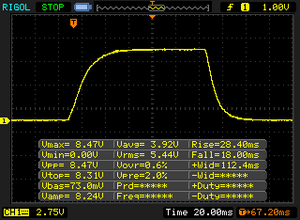 |
| ↘ xviii ms fall | ||
| The screen shows slow response rates in our tests and will be unsatisfactory for gamers. In comparison, all tested devices range from 0.8 (minimum) to 240 (maximum) ms. » 99 % of all devices are better. This ways that the measured response time is worse than the average of all tested devices (23.7 ms). | ||
| ↔ Response Time 50% Grey to 80% Grey | ||
| 60 ms ... rise ↗ and fall ↘ combined | ↗ 26.viii ms rise | 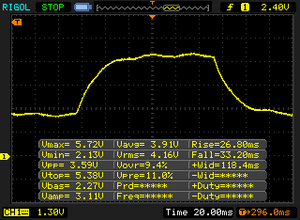 |
| ↘ 33.ii ms fall | ||
| The screen shows boring response rates in our tests and will be unsatisfactory for gamers. In comparison, all tested devices range from 0.eight (minimum) to 636 (maximum) ms. » 95 % of all devices are better. This ways that the measured response time is worse than the boilerplate of all tested devices (37.5 ms). | ||
The visibility outdoors is decent thanks to the loftier luminance as long equally you avoid direct reflections. The viewing angle stability is likewise very good, but you can see a slight red cast from farthermost angles (particularly at an angle from to a higher place/beneath). However, it did not bother us in do.
Dell offers several components for the mobile workstation Precision 7720. It is, for case, possible to select a powerful processor or just a powerful graphics card to come across your requirements. Our test sample is equipped with the most powerful mobile Xeon CPU too as the Quadro P5000 , but you can likewise select a regular Core i7 or even a Core i5 quad-core. You can determine betwixt the electric current Pascal fries from Nvidia (P3000 , P4000 & P5000) and two AMD chips (Radeon Pro WX4130 & 7100).
The mobile Xeon processors can also be combined with ECC-RAM for improved error correction, simply our sample uses regular DDR4-2400 RAM. You can store data on upwardly to ii M.2 drives and one two.5-inch hard bulldoze.
LatencyMon determined some bug for our test model, regardless of whether the wireless connections were agile or not.
Our processor carries the designation Xeon E3-1535M V6 and is based on Intel'south Kaby Lake architecture. Thanks to a maximum Turbo Boost of four.2 GHz (4 cores upward to 3.9 GHz), it is currently the fastest quad-core processor from Intel. The important question with such loftier frequencies is ever how long they can be maintained. The CPU is nonetheless a 45-W CPU but like the popular i7-7700HQ , simply the maximum 3.nine GHz consumes much more than 45 W. Manufacturers can therefore – obviously depending on the cooling capabilities – increase the TDP limits. Many meaty Ultrabooks use this as well, but with limited success. In that location are also mobile workstations where you cannot always employ the full performance potential.
Fortunately, the Precision 7720 is not one of these devices. Dell sets the long-term limit to 60 West, which explains the first-class Cinebench scores. We cannot see the total 4.ii GHz (4.0 - 4.ane GHz), but this tin quickly be affected past groundwork tasks. The mobile Xeon tin can, however, use the total 3.nine GHz for all iv cores in the Multi exam. It consumes about 57 West and warms upward to ~lxxx °C (~176 °F) – good results. This beliefs does not change on battery power.
This means that the mobile Xeon is basically on par with the desktop processor Cadre i7-7700; the 7700K is still a few per centum faster.
We also use our Cinebench loop to check how long the system tin can sustain the performance. The score is mostly stable, and the pocket-size deviations are negligible. This means that the Precision 7720 is 1 of the few systems where the boosted price for the mobile Xeon chips pays off – at to the lowest degree if y'all need the enormous performance.
More technical data and benchmarks for the Xeon E3-1535M v6 are listed in ourTech section .
Cinebench R15 CPU Multi 64 Bit
Cinebench R15 CPU Multi 64Bit
848 Points
Cinebench R15 CPU Single 64Bit
179 Points
Cinebench R15 OpenGL 64Bit
138.38 fps
Cinebench R15 Ref. Match 64Bit
99.half dozen %
Help
Despite the very powerful components, the Precision 7720 is ofttimes beaten by the rivals in the synthetic PCMarks. The trouble is not equally pronounced in the current PCMark 10, merely the older PCMark viii tests in item are probably affected by Toshiba's NVMe-SSD. We will see that SSD benchmarks also take problems with the drive in the side by side department.
The subjective impression, however, is very good, and we did not encounter any problems with the hard- or software during our review period. The system boots upward quickly, is very responsive, and applications are launched with minimal loading times.
| PCMark eight | |
| Dwelling house Score Accelerated v2 | |
| Dell Precision 7710 | |
| HP ZBook 17 G4-Y3J82AV | |
| MSI WE72 7RJ | |
| Dell Precision 7720 | |
| Lenovo ThinkPad P71-20HK0004GE | |
| Piece of work Score Accelerated v2 | |
| Dell Precision 7710 | |
| Fujitsu Celsius H970 | |
| MSI WE72 7RJ | |
| HP ZBook 17 G4-Y3J82AV | |
| Dell Precision 7720 | |
| Creative Score Accelerated v2 | |
| HP ZBook 17 G4-Y3J82AV | |
| Fujitsu Celsius H970 | |
| Lenovo ThinkPad P71-20HK0004GE | |
| Dell Precision 7710 | |
| Dell Precision 7720 | |
| PCMark 10 - Score | |
| HP ZBook 17 G4-Y3J82AV | |
| Dell Precision 7720 | |
| Fujitsu Celsius H970 | |
| PCMark 8 Home Score Accelerated v2 | 3772 points | |
| PCMark viii Creative Score Accelerated v2 | 5498 points | |
| PCMark 8 Work Score Accelerated v2 | 4460 points | |
| PCMark 10 Score | 5248 points | |
| Assist | ||
Nosotros have already mentioned that the Precision 7720 can be equipped with up to three drives: 2x PCIe M.2-2280 SSD with NVMe support and a 2.5-inch slot for a SATA drive. Dell offers different options in its online shop, but you lot tin likewise install additional drives past yourself.
Our exam sample is equipped with a unmarried 512 GB PCIe-SSD (404/475 GB gratuitous afterwards the initial start), but it seems that Dell uses different vendors and we got a Toshiba drive. AS SSD in item still has problems with these models, so the corresponding benchmarks results are missing. Yet, the CrystalDiskMark v scores are decent and easily beat regular SATA-3 SSDs. We did not feel whatsoever other problems with the drive either. Samsung'southward SSDs, still, perform even better, and would as well exist a adept choice for the high-end workstation.
Our comprehensive HDD/SSD list shows how the Toshiba SSD performs compared to other models.
Sequential Read: 1532 MB/s
Sequential Write: 1186.7 MB/southward
4K QD32 Read: 590.33 MB/s
4K QD32 Write: 466.97 MB/s
CDM 5/6 Read Seq Q32T1: 2582.2 MB/s
CDM 5/six Write Seq Q32T1: 1087.7 MB/south
CDM 5/half-dozen Read 4K Q32T1: 551.68 MB/s
CDM 5/vi Write 4K Q32T1: 364.81 MB/due south
CDM five Read Seq: 1853.87 MB/s
CDM 5 Write Seq: 1234.23 MB/south
CDM 5/vi Read 4K: 46.03 MB/s
CDM five/6 Write 4K: 169.xvi MB/s
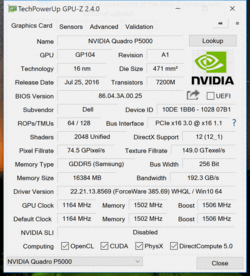
Dell's Precision 7720 supports Nvidia's Optimus engineering science, and so simple workloads are handled by the integratedIntel Hd Graphics P630 of the processor. This creates less rut (less fan activity) and the ability consumption is lower. Nvidia's Quadro P5000 automatically kicks in when you need more than performance. It is based on Nvidia's Pascal architecture and can be compared with the consumer GeForce GTX 1070, but Nvidia has equipped the P5000 with twice the amount of VRAM (16 GB GDDR5). The lower clock of the P5000 is another difference(1164 - 1506 MHz vs. 1443 vs. 1645 MHz), so the operation should be slightly lower.
The professional person Quadro GPUs are equipped with special drivers and ISV certifications to ensure compatibility with professional applications. Drivers can outcome in enormous performance gains, especially in OpenGL optimized software. We utilise the benchmarks SPECviewperf xi & 12, which cover scenarios such equally CAD, CAM, geology, and medical applications (MRI).
The results are quite interesting, and nosotros tin clearly see that the P5000 is not the best pick for every application. The advantage over the other Pascal GPUs is but pocket-size in some cases and certainly does not justify the enormous toll departure, while the P5000 is much faster in other tests. The influence of the drivers is hands visible on the comparison chart for SPECviewperf 12. We added some consumer models, which have amend specifications and should be faster. This is the example in some sub tests, but they can be found at the lesser of the rankings in others.
Many calculations can be transferred from the processor to the graphics card via OpenCL interface, and there are different standards depending on the manufacturer (QuickSync, APP, CUDA). This is often used for video conversion, encryption tasks or financial assay. We utilize the benchmarks LuxMark as well as SiSoft Sandra 2016. The situation is much improve for the Quadro P5000 and it can take the clear lead over the smaller siblings and the predecessor Quadro M5000M.
Lastly, there are DirectX applications, where the raw performance is more than important than the drivers. This includes the constructed 3DMarks and apparently games. Once again we have added some consumer GPUs to give a clearer picture of the classification. Equally we already expected from the lower clocks, the Quadro P5000 is slightly slower than the GTX 1070, but it withal has a comfortable pb over the smaller GTX 1060. The previous Quadro M5000M is as well clearly beaten in this segment. All in all, at that place are no surprises in the DirectX benchmarks.
Unlike the processor, the GPU performance is significantly reduced on battery power. The 3DMark 11 GPU score drops from 19569 to 13059 points, which is a deficit of more than than 30%.
| 3DMark xi - 1280x720 Performance GPU | |
| Guru Mars K | |
| Schenker XMG U507 2017 | |
| Asus Zephyrus GX501 | |
| Lenovo Legion Y920-17IKB | |
| HP ZBook 17 G4-Y3J82AV | |
| Dell Precision 7720 | |
| Fujitsu Celsius H970 | |
| MSI WT72-6QM | |
| Lenovo ThinkPad P71-20HK0004GE | |
| Dell Precision 7710 | |
| MSI WE72 7RJ | |
| 3DMark | |
| 1280x720 Cloud Gate Standard Graphics | |
| Guru Mars 1000 | |
| Schenker XMG U507 2017 | |
| Asus Zephyrus GX501 | |
| Dell Precision 7720 | |
| HP ZBook 17 G4-Y3J82AV | |
| Lenovo Legion Y920-17IKB | |
| MSI WT72-6QM | |
| Lenovo ThinkPad P71-20HK0004GE | |
| Fujitsu Celsius H970 | |
| Razer Blade (2017) UHD | |
| Dell Precision 7710 | |
| MSI WE72 7RJ | |
| 1920x1080 Burn down Strike Graphics | |
| Guru Mars K | |
| Schenker XMG U507 2017 | |
| Asus Zephyrus GX501 | |
| Lenovo Legion Y920-17IKB | |
| Dell Precision 7720 | |
| HP ZBook 17 G4-Y3J82AV | |
| Fujitsu Celsius H970 | |
| Razer Blade (2017) UHD | |
| MSI WT72-6QM | |
| Lenovo ThinkPad P71-20HK0004GE | |
| Dell Precision 7710 | |
| MSI WE72 7RJ | |
| Unigine Heaven 4.0 | |
| Farthermost Preset DX11 | |
| Schenker XMG U507 2017 | |
| Asus Zephyrus GX501 | |
| Dell Precision 7720 | |
| HP ZBook 17 G4-Y3J82AV | |
| Lenovo ThinkPad P71-20HK0004GE | |
| MSI WE72 7RJ | |
| Extreme Preset OpenGL | |
| Dell Precision 7720 | |
| HP ZBook 17 G4-Y3J82AV | |
| Lenovo ThinkPad P71-20HK0004GE | |
| MSI WE72 7RJ | |
| Unigine Valley 1.0 | |
| 1920x1080 Extreme Hard disk drive DirectX AA:x8 | |
| HP ZBook 17 G4-Y3J82AV | |
| Dell Precision 7720 | |
| Lenovo ThinkPad P71-20HK0004GE | |
| MSI WT72-6QM | |
| Dell Precision 7710 | |
| MSI WE72 7RJ | |
| 1920x1080 Extreme HD Preset OpenGL AA:x8 | |
| HP ZBook 17 G4-Y3J82AV | |
| Dell Precision 7720 | |
| Lenovo ThinkPad P71-20HK0004GE | |
| Dell Precision 7710 | |
| MSI WE72 7RJ | |
| 3DMark 11 Performance | 16158 points | |
| 3DMark Ice Storm Standard Score | 58131 points | |
| 3DMark Cloud Gate Standard Score | 28999 points | |
| 3DMark Burn down Strike Score | 12298 points | |
| 3DMark Time Spy Score | 4823 points | |
| Aid | ||
The Quadro P5000 is basically as well a good option for gaming. We only saw that the functioning of the professional GPU is just behind a regular GeForce GTX 1070 (Laptop) and the drivers are not a big problem either (which was not the case a few years agone). But brand-new titles sometimes crave a newer commuter version. You will either have to look for an update from Nvidia or switch to the regular GeForce drivers, which work as well.
We still encountered an interesting miracle during our gaming benchmarks, because some titles were limited to 60 frames per second. We checked the settings (both in-game and drivers) several times, but could non find a solution. Therefore, we have not included results that hit this barrier in the following table. This was the case in the post-obit games: "Witcher iii", "Rainbow Six Siege", and "Battlefield one". The performance of the P5000 is usually sufficient for polish gameplay, even in the native resolution (4K preset).
More gaming benchmarks for the Quadro P5000 are listed here. You can also take the operation of the GTX 1070 as a reference (more results).
The Witcher 3 ultra
The cooling solution is a big advantage of the Precision 7720, considering the fans are deactivated when you perform elementary tasks such as browsing the Internet or installing applications. Peak load is no problem either, which is confirmed by 3DMark 06. The fans only beginning spinning after around xxx seconds, simply are hardly aural at 31 dB(A). The next level is 35 dB(A) after another 45 seconds.
The fan speed is obviously college when you really start to stress the organization. Nosotros see 35 dB(A) in "Witcher iii" at showtime before the fan racket levels off at 41 dB(A). This is also the level for pure CPU load in Prime95. The only really loud scenario is our stress with 45 and later 47.eight dB(A). We would even so say the fan noise is non abrasive since there are no loftier frequencies or pulsating fans. We can hardly criticize the noise levels considering the powerful components (and good operation utilization), and the situation should be meliorate when you choose slower hardware (particularly GPU).
Our test sample did not show any signs of typical coil whine, only we did hear a light whining noise from the SSD when we accessed information.
Noise Level
| Idle | 29.5 / 29.five / 29.five dB(A) | |
| Load | 35 / 47.viii dB(A) | |
 | ||
| 30 dB 40 dB(A) 50 dB(A) | ||
| min: | ||
| Dell Precision 7720 Quadro P5000, E3-1535M v6, Toshiba NVMe THNSN5512GPU7 | Lenovo ThinkPad P71-20HK0004GE Quadro P3000, i7-7820HQ, Samsung PM961 NVMe MZVLW512HMJP | HP ZBook 17 G4-Y3J82AV Quadro P5000, E3-1535M v6, Samsung SSD SM961 1TB M.2 MZVKW1T0HMLH | MSI WE72 7RJ Quadro M2200, i7-7700HQ, Samsung SM961 MZVPW256 m.2 PCI-e | Fujitsu Celsius H970 Quadro P4000, E3-1535M v6, Samsung SM961 MZVKW512HMJP m.2 PCI-e | |
|---|---|---|---|---|---|
| Noise | ii% | -7% | -14% | -10% | |
| off / environment * | 29.5 | 29.2 1% | 29.6 -0% | 29.3 i% | 30.2 -2% |
| Idle Minimum * | 29.5 | 29.ii i% | 29.half dozen -0% | 36.3 -23% | 30.ii -2% |
| Idle Boilerplate * | 29.5 | 29.2 1% | 31.7 -7% | 36.3 -23% | 32.8 -11% |
| Idle Maximum * | 29.v | 32.2 -nine% | 34.iv -17% | 36.half dozen -24% | 32.8 -11% |
| Load Average * | 35 | 34.7 1% | 41.3 -eighteen% | 40.4 -15% | 47.three -35% |
| Witcher iii ultra * | 41 | 45.6 -eleven% | |||
| Load Maximum * | 47.viii | 39.i 18% | 45.half-dozen 5% | 46.6 3% | 47.3 i% |
* ... smaller is improve
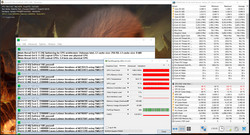
The surface temperatures are well nether control, despite the high performance. The whole chassis remains very cool during calorie-free workloads and while idling, just the temperature distribution is besides very convincing under load. The warmest area is the top center, and the heat radiates from in that location. You will notice the warm keyboard during typing, but information technology is never uncomfortable, and the palm rests always stay cool. The hot spot is at the bottom, but 45 °C (~113 °F) is inappreciably troubling for the level of performance.
Both components perform very well individually, but the stress test with the tools Prime95 and FurMark still shows the limitations of the cooling solution. The CPU starts with 4x 3.iii GHz (~55 Due west), but rapidly warms up to more 90 °C (~194 °F). The GPU on the other hand manages a cadre clock between 1490 - 1582 MHz.
The CPU gets close to 100 °C (~212 °F) afterward 5 minutes and drops to only 2.7 - ii.8 GHz as soon as it hits 98 °C (~208 °F). Even so, the clocks will rise again as soon as the temperature drops. This loop continues over the course of the test and the result is an average consumption of 45 W, which corresponds with a clock of iii GHz. It might take been a meliorate solution to just set a fixed limit at 45 W for this scenario. The power consumption also fluctuates between 160 and 200 W depending on the clocks.
The GPU levels off at 1400 - 1500 MHz after 5 minutes and does non get too hot at 64 °C (~147 °F). A 3DMark 11 run immediately after the stress examination did not show whatever functioning limitations.
| |||||||||||||||||||||||||
| Maximum: 42.3 °C = 108 F Average: 35.half-dozen °C = 96 F | |||||||||||||||||||||||||
| |||||||||||||||||||||||||
| Maximum: 44.9 °C = 113 F Average: 34.9 °C = 95 F | |||||||||||||||||||||||||
Power Supply (max.) 41.1 °C = 106 F | Room Temperature 20.viii °C = 69 F | Voltcraft IR-900
| |||||||||||||||||||||||||
| Maximum: 26.1 °C = 79 F Boilerplate: 25.2 °C = 77 F | |||||||||||||||||||||||||
| |||||||||||||||||||||||||
| Maximum: 27.9 °C = 82 F Boilerplate: 26.4 °C = 80 F | |||||||||||||||||||||||||
Power Supply (max.) 25.8 °C = 78 F | Room Temperature 21.5 °C = 71 F | Voltcraft IR-900
| |||||||||||||||||||||||||
| Maximum: 42.ii °C = 108 F Average: 35.1 °C = 95 F | |||||||||||||||||||||||||
| |||||||||||||||||||||||||
| Maximum: 42.4 °C = 108 F Average: 34.8 °C = 95 F | |||||||||||||||||||||||||
Power Supply (max.) 41.iv °C = 107 F | Room Temperature 21.4 °C = 71 F | Voltcraft IR-900
(±) The average temperature for the upper side under maximal load is 35.6 °C / 96 F, compared to the average of 31.8 °C / 89 F for the devices in the class Workstation.
(±) The maximum temperature on the upper side is 42.3 °C / 108 F, compared to the average of 37.nine °C / 100 F, ranging from 22.2 to 69.8 °C for the class Workstation.
(±) The bottom heats upward to a maximum of 44.9 °C / 113 F, compared to the average of 41.4 °C / 107 F
(+) In idle usage, the average temperature for the upper side is 25.ii °C / 77 F, compared to the device average of 31.eight °C / 89 F.
(±) Playing The Witcher 3, the average temperature for the upper side is 35.one °C / 95 F, compared to the device average of 31.8 °C / 89 F.
(+) The palmrests and touchpad are cooler than peel temperature with a maximum of 27.3 °C / 81.1 F and are therefore cool to the touch.
(±) The average temperature of the palmrest area of similar devices was 27.8 °C / 82 F (+0.5 °C / 0.9 F).
The Precision 7720 consumes a lot of power, but there is non much criticism when yous consider the vivid 4K screen and the powerful components. The value fluctuates between 160 and the maximum 202 Westward (depending on the CPU clock) under load. However, the comparison with the erstwhile Quadro M5000M in the MSI WT72 shows that the new Quadro P5000 is much more than efficient. The MSI is much slower and merely has a 1080p screen, merely consumes a similar amount of ability under load.
The 240-Westward ability adapter is not very light at 972 g (~2.1 lb), simply all the same has plenty of headroom in return.
| Dell Precision 7720 E3-1535M v6, Quadro P5000, Toshiba NVMe THNSN5512GPU7, IGZO, 3840x2160, 17.30 | Lenovo ThinkPad P71-20HK0004GE i7-7820HQ, Quadro P3000, Samsung PM961 NVMe MZVLW512HMJP, IPS, 3840x2160, 17.xxx | HP ZBook 17 G4-Y3J82AV E3-1535M v6, Quadro P5000, Samsung SSD SM961 1TB Thou.ii MZVKW1T0HMLH, IPS, 3840x2160, 17.thirty | MSI WE72 7RJ i7-7700HQ, Quadro M2200, Samsung SM961 MZVPW256 one thousand.2 PCI-e, IPS, 1920x1080, 17.30 | Fujitsu Celsius H970 E3-1535M v6, Quadro P4000, Samsung SM961 MZVKW512HMJP m.2 PCI-eastward, IPS LED, 1920x1080, 17.30 | MSI WT72-6QM E3-1505M v5, Quadro M5000M, Toshiba NVMe THNSN5256GPU7, IPS, 1920x1080, 17.thirty | |
|---|---|---|---|---|---|---|
| Power Consumption | 17% | -five% | -2% | xiv% | -48% | |
| Idle Minimum * | 9.6 | 7.44 22% | 12.9 -34% | fifteen -56% | ten.7 -11% | 24.8 -158% |
| Idle Average * | 20.five | 18 12% | 19.vi 4% | 20.i 2% | fifteen.eight 23% | 29.7 -45% |
| Idle Maximum * | 22.9 | 21.8 five% | 23.6 -3% | 23.viii -four% | 17.8 22% | xxx.1 -31% |
| Load Average * | 96.8 | 77.1 20% | 92.8 4% | 85.6 12% | 92 v% | 105.2 -9% |
| Load Maximum * | 202.one | 150.5 26% | 190 6% | 128 37% | 137 32% | 192.2 5% |
| Witcher 3 ultra * | 148.5 |
* ... smaller is meliorate
Our examination sample of the predecessor Precision 7710 was still equipped with a 72 Wh battery, simply the 7720 now gets a 91 Wh module (6 cells) by default (the 72 Wh battery is yet available as an accessory). The mobile workstation performs well, cheers to the switchable graphics, and the results should exist even better when you get an SKU with a lower display resolution. The maximum runtime is more than xi hours, but the battery simply lasts for little more one hour under load. The SPECviewperf 12 benchmarks also drain the battery afterward merely 61 minutes. The GPU performance in particular is reduced in this scenario, otherwise the battery would discharge also apace (high temperature), which could damage the bombardment.
We can make up one's mind more than than 6 hours in our tests at an adapted luminance of 150 nits (WLAN and Video). The charging process is pretty fast. A total charge takes about 2.five hours, but 30% subsequently thirty minutes and 50% subsequently 50 minutes is not bad.
Bombardment Runtime
| Idle (without WLAN, min effulgence) | 11h 25min | |
| WiFi Websurfing (Edge 40.15063.0.0) | 6h 19min | |
| Large Buck Bunny H.264 1080p | 6h 45min | |
| Load (maximum brightness) | 1h 10min |
| Dell Precision 7720 E3-1535M v6, Quadro P5000, 91 Wh | Lenovo ThinkPad P71-20HK0004GE i7-7820HQ, Quadro P3000, 96 Wh | HP ZBook 17 G4-Y3J82AV E3-1535M v6, Quadro P5000, 95 Wh | MSI WE72 7RJ i7-7700HQ, Quadro M2200, 51 Wh | Fujitsu Celsius H970 E3-1535M v6, Quadro P4000, 96 Wh | Dell Precision 7710 E3-1535M v5, FirePro W7170M, 72 Wh | |
|---|---|---|---|---|---|---|
| Battery Runtime | 11% | -11% | -52% | 34% | 0% | |
| Reader / Idle | 685 | 872 27% | 469 -32% | 268 -61% | 1002 46% | 775 xiii% |
| H.264 | 405 | 517 28% | 316 -22% | 181 -55% | 573 41% | 283 -xxx% |
| WiFi v1.3 | 379 | 358 -6% | 295 -22% | 177 -53% | 542 43% | 365 -iv% |
| Load | 70 | 66 -6% | 92 31% | 42 -forty% | 74 half-dozen% | 85 21% |
Pros
+ loftier-quality & sturdy example
+ good & very bright 4K display
+ splendid performance, likewise under load
+ simple maintenance
+ decent port selection
+ individual configurations
+ depression emissions
+ battery runtime
+ input devices
Cons
- backlight bleeding at the lower border
- PWM at low effulgence levels
- brandish should be calibrated for all-time functioning
- SD reader did not work on our test sample
- poor position of the SIM slot
- expensive
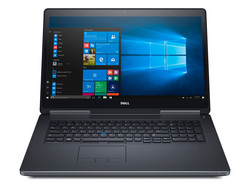
Dell's Precision 7720 is a very powerful mobile workstation. The loftier-quality case is basically unchanged from the previous generation and you lot now get a Thunderbolt 3 port by default. The predecessor still had problems to use its potential in combined workloads for CPU & GPU, but it seems the manufacturer has improved this aspect. Our test sample is equipped with the about powerful components, but the functioning utilization is yet very practiced, even under extreme load. Whether you demand this corporeality of operation is manifestly another question. The graphics menu in particular is not necessary for many scenarios.
We are rather disappointed by the 4K PremierColor display. This is plain moaning on a high level, but we would have expected better results ex-works for the boosted price. A calibration is definitely recommended for this device. The backlight bleeding at the bottom edge is besides a fleck annoying, and the panel uses PWM at low effulgence levels.
The Precision 7720 is a good choice when you need a lot performance, because the mobile workstation can actually employ the performance of the expensive components.
There is no trouble with annoying fans, despite the high performance. Sure, yous can conspicuously hear them under high workloads, just they are often turned off when you perform simple tasks. We cannot really criticize the temperature evolution either, which is also the case for the battery runtime.
Except for the drawbacks of the display, you lot have to look closely to discover issues. The listing obviously includes the SD reader, which did not work on our test model, but this should be an isolated incident. The SIM slot is located inside the chassis and hard to reach, which prevents a quick switch of the information menu in other countries, for example.
All of this operation is obviously not cheap, but this is the case for the competition besides. All in all, the Precision 7720 tin secure a very good rating (89%).
Dell Precision 7720 - 2018-01-21 01/21/2018 v6(onetime)
Andreas Osthoff
Workstation - Weighted Average
Related Manufactures
Andreas Osthoff, 2018-01-24 (Update: 2020-05-19)
Source: https://www.notebookcheck.net/Dell-Precision-7720-Xeon-P5000-4K-Workstation-Review.279706.0.html

0 Response to "Dell Precision 7720 Can You Upgrade the Gpu to Nvidia Gtx 1080"
Post a Comment